Are you in the middle of the complex task of choosing the perfect IT Service Management (ITSM) solution? Comparing TeamDynamix vs. ManageEngine? Look no further - we've got you covered.
Optimizing service delivery and enhancing operational efficiency are paramount. The cornerstone to achieving these goals is choosing is selecting the right service desk software.
In this blog post, we'll dive deep into an ITSM tools comparison between these two platforms. But if neither of them entirely meets your unique requirements, we have an alternative solution that might just be your perfect match – InvGate Service Management. This robust ITSM platform offers an impressive array of features designed to streamline your service delivery and empower your organization.

Table of contents
- TL;DR
- What is TeamDynamix?
- What is ManageEngine?
- Considering InvGate Service Management as an ITSM solution alternative
TL;DR
- TeamDynamix stands out with its ability to provide customized solutions, a user-friendly interface, and a reliable ticketing system. However, it has faced criticism for its integration challenges, complexities in Ticket Management, and outdated user interface.
- ManageEngine has garnered extensive recognition for its extensive range of products and impressive expansion. Recent revelations have highlighted potential limitations in its integrations outside of the Zoho Ecosystem, raising concerns about vulnerabilities. These concerns were compounded by a significant setback in 2023.
- InvGate Service Management stands out with its exceptional ticketing system, user-friendly interface, cost-effective solutions, and remarkable IT Asset Management capabilities.
We tried to be as thorough as possible, but if you don't have enough time to read it through and through, here's (another) TL;DR: InvGate Service Management can do everything we say here, and you can test it right away for free for 30 days.
Most looked-at features by buyers
When users evaluate their options for IT Service Management solutions, they focus on specific features that align with the needs of their organization. It's crucial to grasp these desired functionalities to make well-informed decisions. Now, let's delve into the key factors that potential purchasers typically take into consideration when comparing various ITSM tools:
- Cost and support - Buyers evaluate the overall cost-effectiveness of the solution, taking into account licensing models, subscription plans, and any additional expenses related to features or users. The availability of reliable customer support, comprehensive documentation, and accessible training resources significantly influences their decision-making.
- User-friendly experience and interface - Ease of use and the design of the user interface are critical factors for buyers. They highly value a user-friendly platform with an intuitive interface that enhances user adoption and productivity. Mobile accessibility is also essential, especially for organizations with remote or mobile workforces.
- Adaptability - Buyers prefer software solutions that can be customized to align with their business needs. This ensures that the software accommodates their unique workflows and processes, ultimately increasing user satisfaction and operational efficiency.
- Ticket Management System - Prospective buyers attach significant importance to integrating a comprehensive Ticket Management system into the help desk software. This feature facilitates the efficient tracking, assignment, and resolution of customer inquiries and support requests.
- Scalability and customization - Organizations with evolving requirements prioritize solutions that can adapt to their growth and allow for customization. Buyers specifically look for the ability to create custom fields, workflows, and extensions/plugins to meet their unique business needs.
- Simplified IT service catalog - Organizations often require a streamlined IT service catalog that provides a centralized platform for users to request specific IT services or resources. This simplifies service requests, enhances visibility, and aids in effective service delivery management.
- Self-service portal and knowledge base - Including a self-service portal is highly appreciated because it empowers end-users to independently resolve common issues and access relevant information without needing direct assistance.
- Support automation and Workflow Management - Buyers seek software solutions with automation capabilities to streamline routine tasks such as ticket routing, approvals, and escalations. These automation features contribute to increased efficiency and productivity.
- Informative reporting - Buyers actively seek help desk software equipped with robust reporting tools like dashboards and reports. These features offer valuable insights into IT operations and performance, aiding in informed decision-making and continuous service improvement.
- Seamless integration capabilities - The ability to seamlessly integrate with other systems and applications is a vital requirement for buyers. They seek a smooth data flow and automated processes, valuing the capability to integrate with existing tools and platforms to enhance efficiency and provide a unified user experience.
- Efficient IT Asset Management - Users prioritize software that offers robust IT Asset Management capabilities, which assist in maintaining accurate inventories and optimizing resource utilization within their organizations.
- ITIL compliance - Many organizations place a premium on adhering to ITIL best practices. Therefore, buyers may favor solutions that support ITIL processes, including Incident Management, Problem Management, Change Management, and Asset Management.
What is TeamDynamix?
TeamDynamix is a cloud-driven solution that functions in IT Service Management, Project Portfolio Management (PPM), and Integration Platform as a Service (iPaaS) segments, all provided via a Software-as-a-Service (SaaS) approach. This advancement empowers educational institutions, such as colleges, universities, and other organizations, to synchronize, collaborate, and optimize their operational workflows.
What users like from TeamDynamix
TeamDynamix has received commendable user feedback from reputable industry sources, including Gartner. These reviews underscore several significant strengths and benefits of the platform. Let's delve deeper into these highlighted advantages.
- Robust dashboards - TeamDynamix features powerful dashboards that provide teams with effective management tools. These dashboards facilitate seamless monitoring and collaboration among team members, ultimately boosting productivity.
- Customization options - Users appreciate the extensive customization possibilities offered by TeamDynamix. These options empower them to configure the platform precisely to their unique requirements, allowing for the creation of tailored workflows and processes.
- User-friendly interface - TeamDynamix has an intuitive user interface that simplifies the assignment and management of tasks and the submission of requests. Users find it exceptionally easy to navigate, which enhances their daily task efficiency.
- Dependable ticketing module - The ticketing module consistently receives accolades for its stability and reliability. It equips users with the tools to efficiently organize and track project tickets, streamlining project management efforts.
- Responsive customer support - Users consistently commend the responsiveness and helpfulness of TeamDynamix's support team. They receive timely assistance when facing challenges or seeking guidance, contributing to a smoother overall user experience.
- Effortless implementation - The platform stands out for its ease of implementation, requiring no prior programming expertise. This accessibility lowers entry barriers for organizations, ensuring a straightforward onboarding process.
What users don’t like from TeamDynamix
While TeamDynamix has many strengths and positive attributes, it has not been immune to user criticism, particularly in reviews from reputable sources such as Gartner. Here are some of the issues that have surfaced and warrant attention.
- Limited desktop sharing and updates - Concerns have been raised about the platform's inability to facilitate desktop sharing and its infrequent updates once they are pushed out. This limitation has restricted flexibility and usability for certain organizations.
- Integration with ITSM suites - Users have expressed frustration over the platform's inability to seamlessly integrate with a full IT Service Management suite. They have also noted a deficiency in robust Change and Configuration Management software.
- Complex user interface - TeamDynamix has faced criticism for its user interface complexity. Users have cited challenges stemming from an outdated layout, limited customization options, and awkward ticket and comment layouts. Many are advocating for a more modern and user-friendly graphical user interface (GUI).
- Ticket Management challenges - Users have reported various difficulties in Ticket Management. These include the system's inability to sort tickets by due date, challenges with the workflow designer, and the absence of essential features like batch delete in Asset Management.
- Complex workflow structures - TeamDynamix has received criticism for its intricate workflow structures, which have posed navigation and implementation challenges for some users.
- Limited reporting - Some users have found the reporting capabilities within the system lacking. They desire more extensive integration between project and ticketing applications to improve their ability to generate and analyze reports effectively.
- User experience enhancement needed - Despite being generally regarded as user-friendly, some users have encountered challenges in their overall experience. Specifically, they have found sorting and searching for tickets less intuitive. The abundance of customization options has also been overwhelming for some users.
- Permissions management challenges - Reports have emerged regarding issues with how the vendor handles write/view/access permissions. These difficulties have resulted in user access and security concerns.
- Delayed enhancement addressing - Users have expressed frustration over lengthy wait times for enhancements to be addressed, impacting their ability to utilize the platform effectively.
- Limited support - A significant drawback that has gained attention is the platform's inadequate support during critical outages. Users have reported feeling left without assistance during crucial downtime situations. Furthermore, some have expressed dissatisfaction with the level of assistance provided by direct support channels.
- Outage page accessibility - Requiring login to access the outage page has been seen as an impediment, preventing users from obtaining critical information during system downtime.
What’s TeamDynamix’s argument over ManageEngine?
Here are TeamDynamix's key competitive advantages over ManageEngine:
- Agile dashboards - TeamDynamix's dashboards facilitate team collaboration and productivity.
- Extensive customization - TeamDynamix's customization options empower users to tailor the platform.
- User-friendly interface - TeamDynamix offers an intuitive interface that enhances operational efficiency.
- Dependable ticketing module - TeamDynamix's ticketing module earns praise for reliability.
- Responsive support - TeamDynamix's customer support is lauded for its responsiveness.
- Effortless implementation - TeamDynamix's straightforward onboarding sets it apart.
What is ManageEngine?
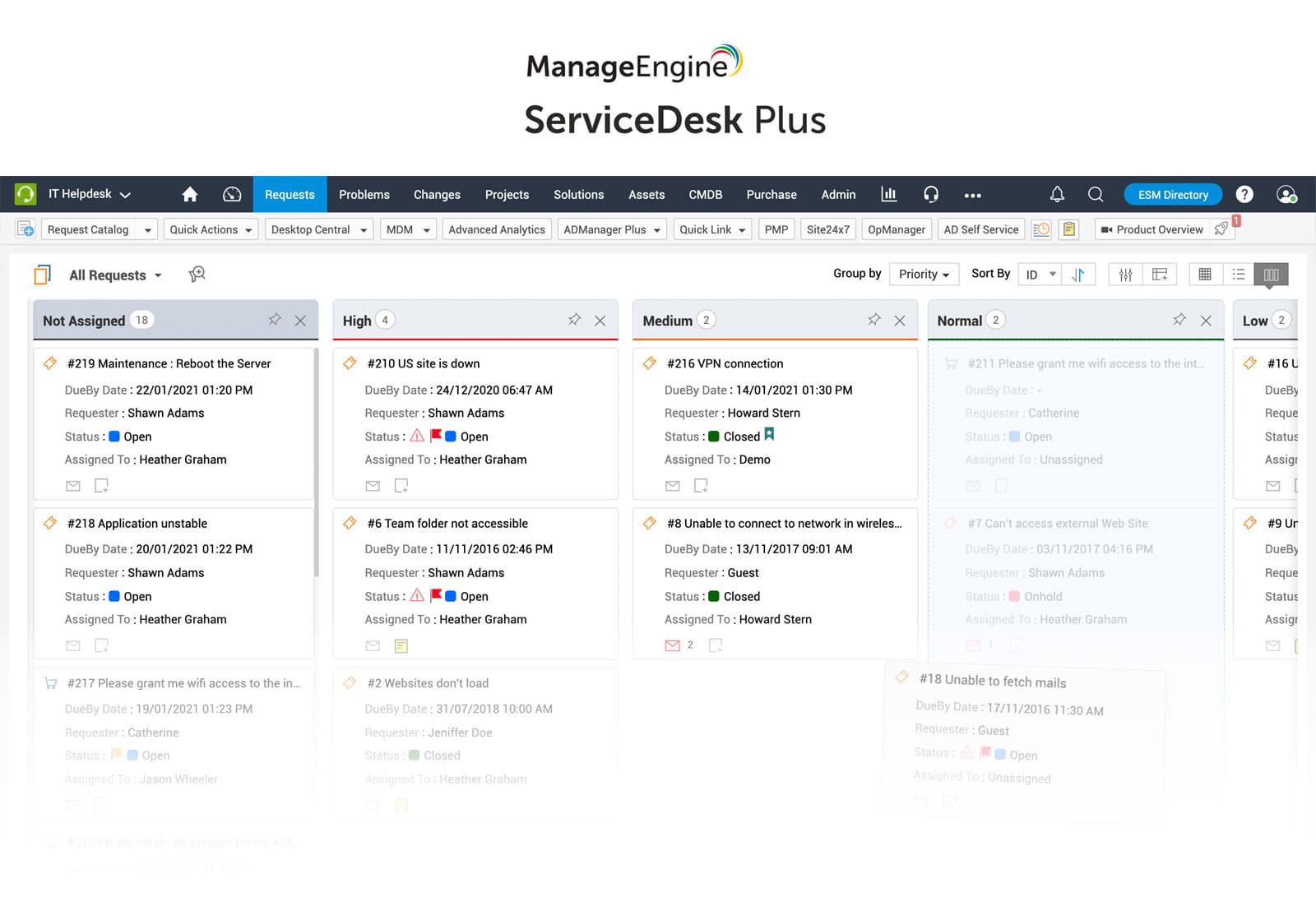
Formerly known as AdventNet Inc., ManageEngine underwent a rebranding in 2009 and currently operates under the name Zoho Corporation. This company specializes in providing comprehensive IT Management solutions, primarily targeting small and midsize businesses. Its headquarters are located in Pleasanton, California, and it has built a significant global presence, serving over 180,000 customers worldwide.
One of ManageEngine's notable offerings is ServiceDesk Plus, a platform that offers flexible deployment options, including both cloud-based and on-premise solutions. ServiceDesk Plus covers a wide range of capabilities, including IT Service Management and IT Asset Management. In the Gartner Magic Quadrant, ManageEngine is positioned as a Challenger, signifying its strong competitive position in the market.
What users like from ManageEngine
ManageEngine has garnered recognition from reputable entities like Gartner, which underscores the positive feedback and satisfaction of its customers. Let's delve into some of the key benefits highlighted by users.
- Extensive product lineup - ManageEngine provides a wide array of complementary products covering different areas, such as endpoint management, network monitoring, application monitoring, and active directory management solutions. By harnessing the low-code development capabilities and business integrations offered by its parent company, Zoho, ManageEngine offers a comprehensive range of platform capabilities. This diverse product portfolio opens up opportunities for cross-selling and delivers enhanced value to customers.
- Competitive pricing approach - The platform distinguishes itself with its competitive pricing strategy, providing highly cost-effective ITSM solutions. With multiple pricing tiers available, the software caters to various budget constraints, making it an attractive choice for midmarket customers and larger organizations seeking value-driven solutions.
- Impressive growth trajectory - ManageEngine has demonstrated substantial growth potential, evident through its flexible deployment options and successful positioning within the midmarket segment. In 2021, the company achieved significant revenue growth and expanded its customer base considerably. Particularly in the enterprise sector, ManageEngine has enjoyed significant success, establishing itself as a rapidly expanding player in the industry.
What users don’t like from ManageEngine
While ManageEngine has many strengths and positive attributes, it has not escaped the concerns raised by customers in reviews from trusted sources such as Gartner. Let's look at some specific areas that have raised customer objections.
- Limited integrations outside the Zoho ecosystem - ManageEngine's integration capabilities are most robust when used with other ManageEngine and Zoho ecosystem products. This could pose challenges for customers seeking seamless integration with widely used IT Operations Management (ITOM) tools outside the Zoho ecosystem. Such customers may need to develop custom API connections to bridge the gap.
- Security vulnerabilities in 2023 - ManageEngine faced a significant setback in 2023 when two critical vulnerabilities were identified across 24 of its products. These vulnerabilities were rated as highly severe, as they had the potential to enable remote execution of malicious code. However, to its credit, the company promptly addressed this situation by releasing patches to rectify the vulnerabilities and bolster its security measures.
- Limited emphasis on product innovation - ManageEngine's primary focus appears to be on improving processes, facilitating integrations, and providing support for customization rather than pushing the envelope in terms of product innovation. Although the company has incorporated some AI/ML capabilities in specific areas like field and template recommendations, it lags behind more advanced products in this category.
- Lack of clear differentiation in IT Service Management (ITSM) marketing - ManageEngine's marketing efforts have sometimes fallen short in effectively highlighting its unique value proposition within the ITSM market. By predominantly focusing on common themes like low-code development, customer privacy, and deployment flexibility, the company struggles to set itself apart from more established competitors in the market.
What’s ManageEngine’s argument over TeamDynamix?
ManageEngine makes a compelling case against its competitor, TeamDynamix. To understand the strengths and advantages that ManageEngine brings to the table, let's explore the key points of contention and differentiation.
- Comprehensive product range - ManageEngine offers a broad spectrum of IT management solutions, from endpoint management to network monitoring and more. Backed by Zoho's integration capabilities, it delivers a holistic suite of services.
- Competitive pricing - ManageEngine's cost-effective pricing, complete with various tiers, appeals to a wide audience. This affordability makes it an appealing choice, especially for budget-conscious organizations.
- Remarkable growth - ManageEngine's flexible deployment options and strong midmarket presence have fueled its rapid growth. It saw substantial revenue and customer base expansion in 2021, particularly in the enterprise sector.
Considering InvGate Service Management as an ITSM solution alternative
While TeamDynamix and ManageEngine are recognized players in IT Service Management, exploring alternative solutions that can effectively cater to your organization's unique requirements is crucial. In this context, InvGate Service Management is a compelling choice that deserves careful consideration.
Let's delve into the comprehensive features of InvGate Service Management that establish it as a valuable option for fulfilling your organization's ITSM needs.
Cost-effective solution
InvGate Service Management provides a cost-effective solution without compromising on functionality. It offers a comprehensive suite of ITSM features at a competitive price point, making it an appealing choice for organizations seeking affordability without sacrificing capabilities. In comparison to alternatives like TeamDynamix and ManageEngine, InvGate Service Management strikes a balance between cost and functionality.
Simplified configuration and setup
InvGate Service Management streamlines the configuration and setup process with a user-friendly, no-code/low-code approach. This approach empowers both novice and experienced users to implement the system without requiring extensive technical expertise. The platform offers straightforward configuration options, enabling organizations to harness its robust ITSM capabilities swiftly.
Comprehensive Asset Management
By integrating InvGate Service Management with InvGate Asset Management, organizations gain a comprehensive view of their IT ecosystem, resulting in improved service delivery and reduced downtime. InvGate Asset Management offers features such as IT Asset Discovery, Inventory Management, Software License Management, and maintenance schedules.

ITIL best practice compliance
InvGate Service Management has earned the prestigious PinkVERIFIED Certified certification, underscoring its commitment to maintaining ITSM excellence. Whether organizations are embarking on their ITIL journey or managing complex operations, InvGate Service Management offers a user-friendly and feature-rich experience aligned with industry best practices.
Exceptional user experience
InvGate Service Management strongly emphasizes delivering an outstanding user experience through meticulous design and adherence to UI/UX best practices. Its intuitive interface encourages rapid adoption, reducing the need for extensive training and maximizing overall productivity.
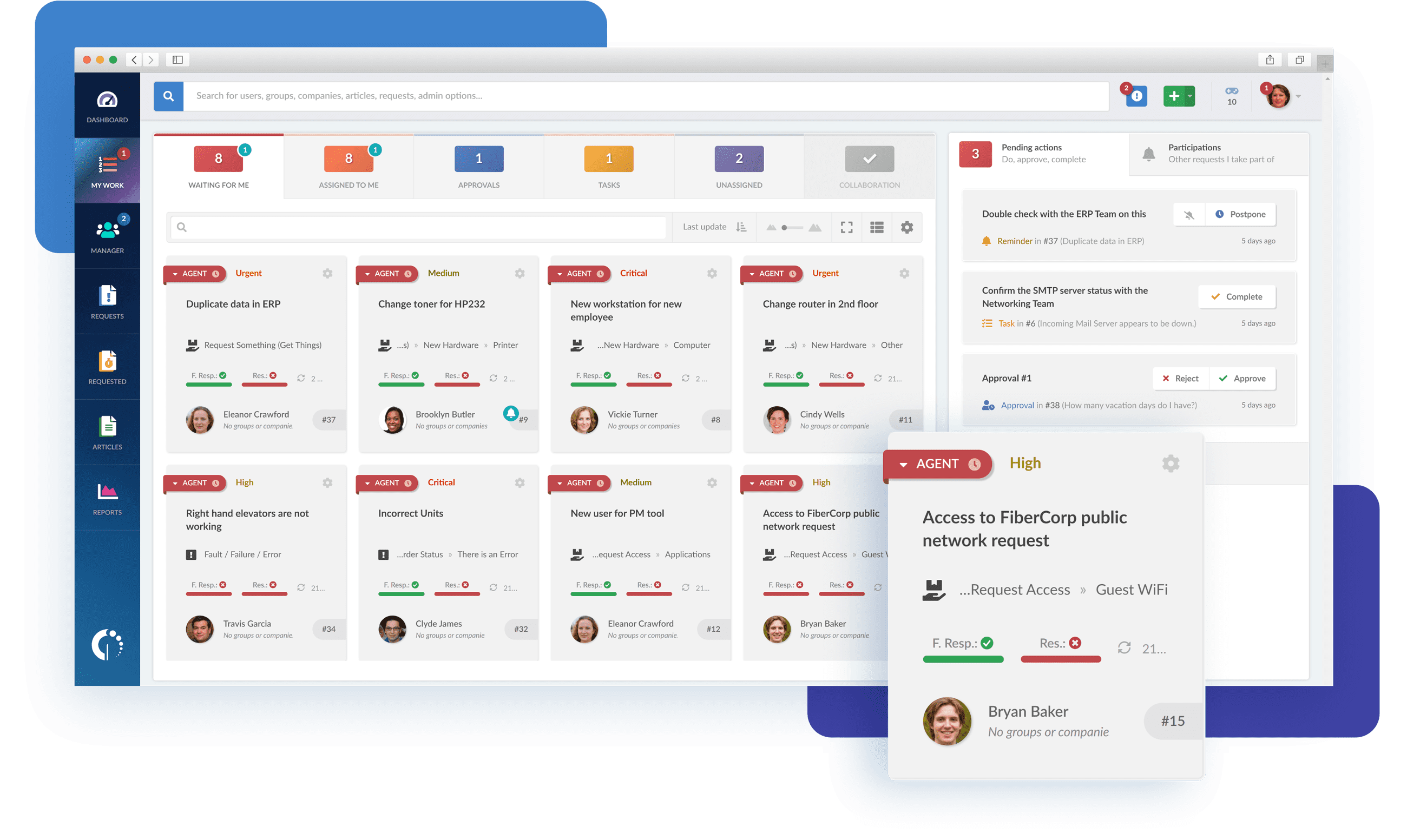
Customization and flexibility
InvGate Service Management provides flexible deployment options, allowing organizations to choose between on-premise or cloud-based solutions. This flexibility ensures that the platform can effectively meet the specific demands of various sectors and industries.
Robust Ticketing and Incident Management
InvGate Service Management offers powerful capabilities for efficient ticket tracking, collaboration, and resolution. Features such as automated ticket routing, customizable workflows, and SLA Management enable IT teams to manage and prioritize incidents effectively.
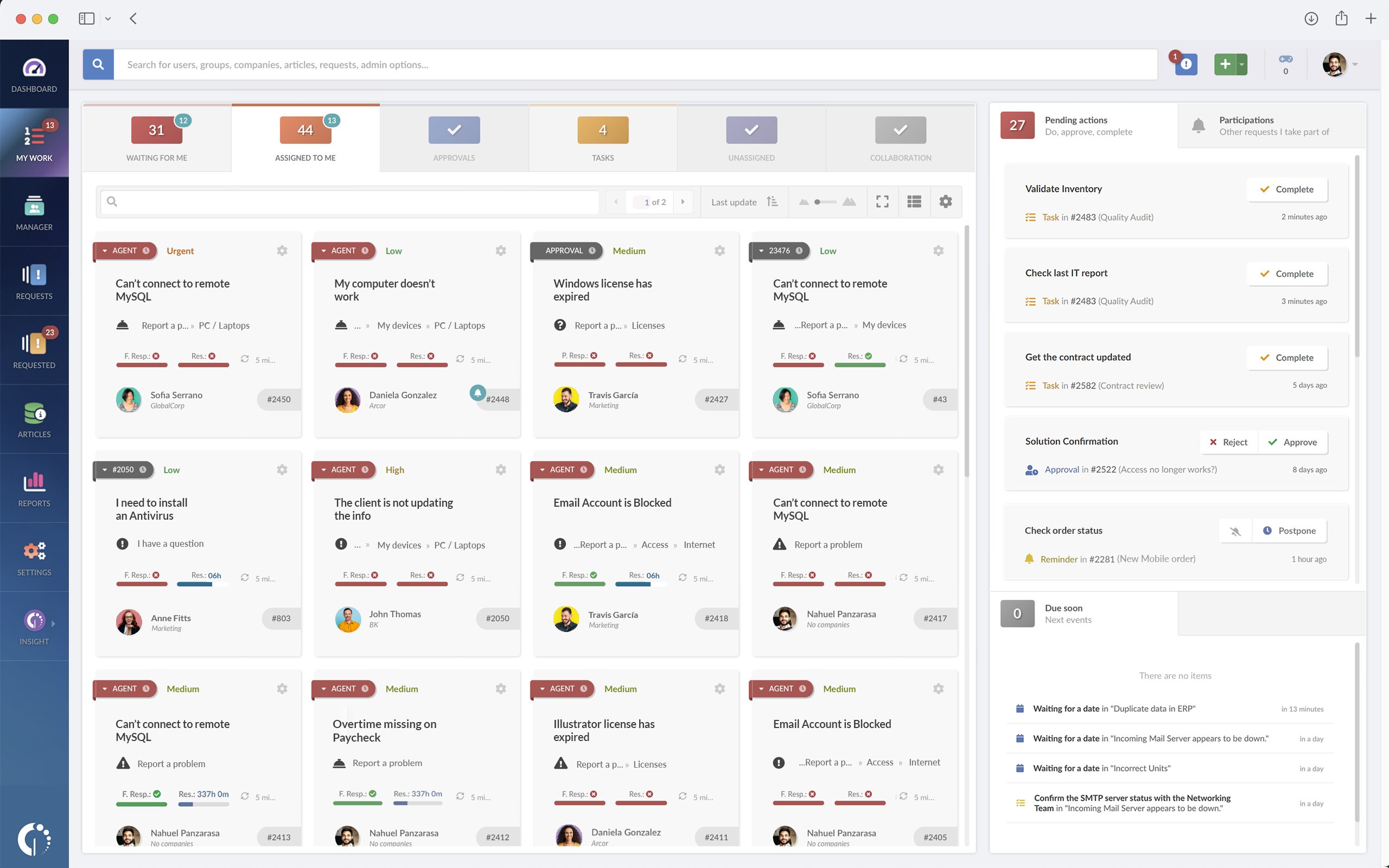
Strong self-service capabilities
InvGate Service Management offers robust self-service functionalities, including a user-friendly portal, an extensive IT service catalog, and a knowledge base. These features empower end-users to independently address common issues, access various IT services, and utilize self-help resources, thereby reducing the workload on IT staff.
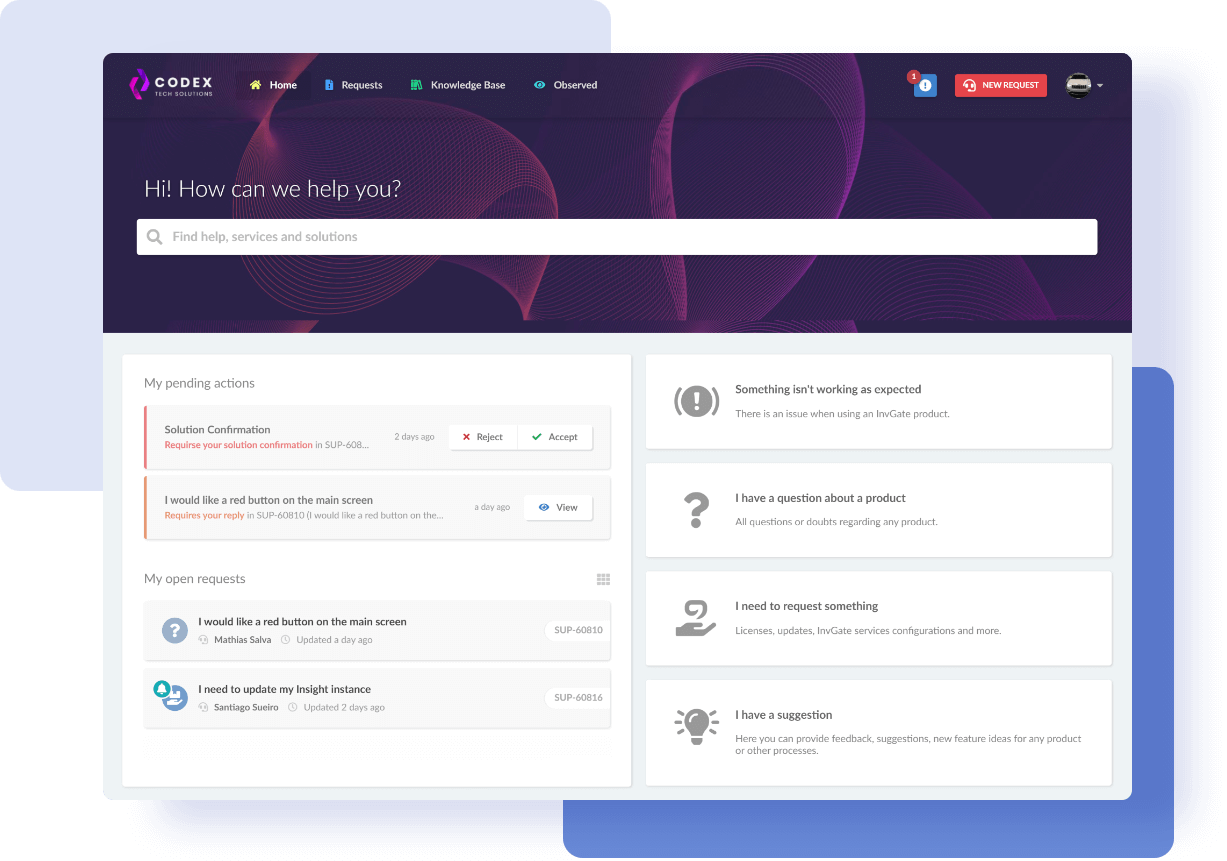
Comprehensive reporting and analytics
InvGate Service Management provides extensive reporting and analytics functionalities, enabling organizations to gain valuable insights into their IT operations and performance. The platform offers ready-to-use reports and customizable dashboards, allowing IT teams to analyze data, identify patterns, and make informed decisions to enhance their services.
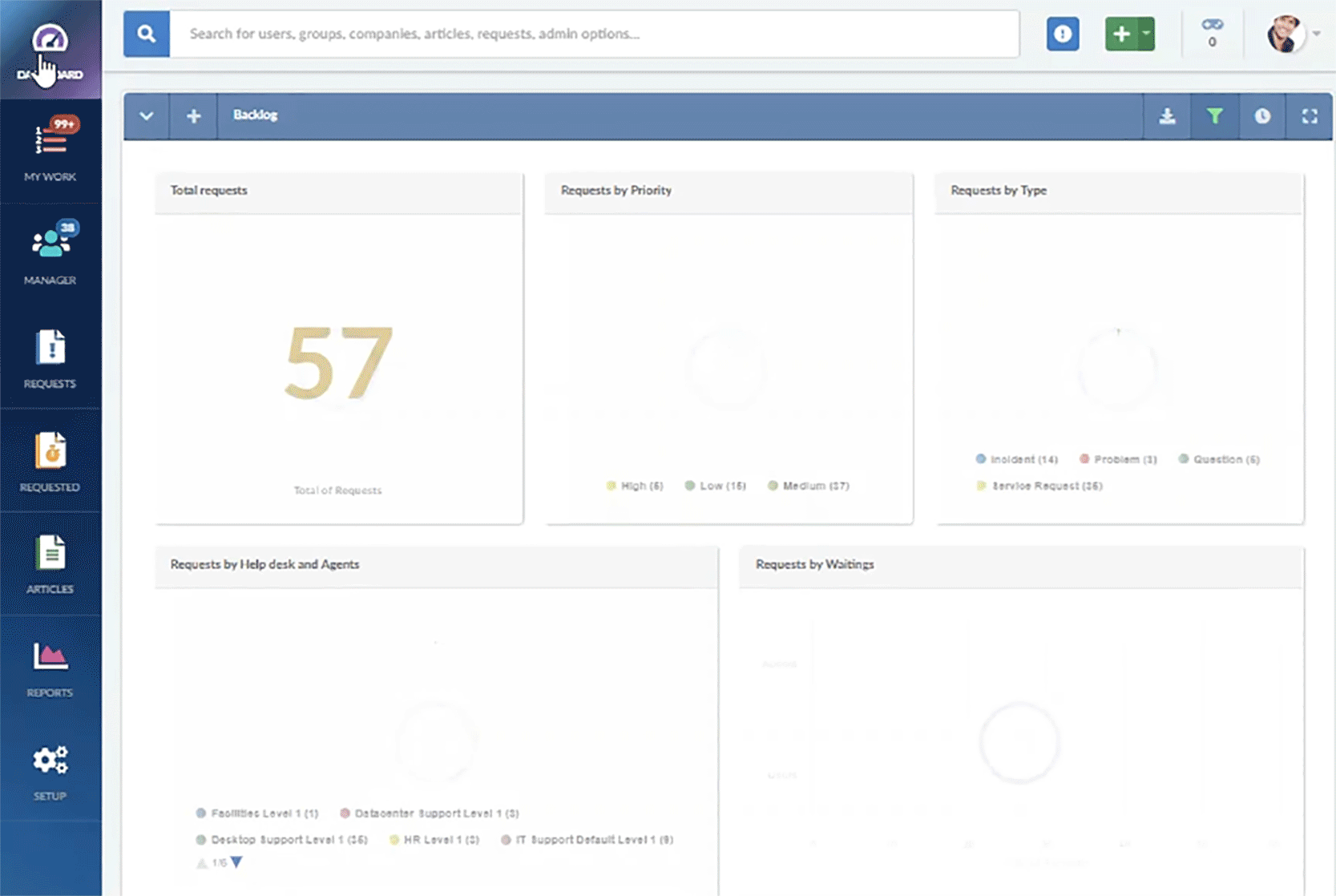
Focused on ITSM with ESM extension
InvGate Service Management is purpose-built for ITSM and seamlessly extends its capabilities to Enterprise Service Management (ESM). This empowers operational departments to enhance their processes and fully embrace the advantages of digital transformation. With a primary focus on ITSM and strong performance in ESM, InvGate Service Management facilitates streamlined workflows and comprehensive digital transformation initiatives across all departments.
Fast ROI and ongoing innovation
InvGate Service Management ensures a swift return on investment through efficient implementation processes. Within weeks, organizations can begin enjoying the benefits of this robust ITSM solution. Additionally, regular feature updates keep users at the forefront of technology without incurring additional costs.
Next steps
In the dynamic world of IT Service Management, the TeamDynamix vs. ManageEngine comparison has highlighted critical factors that every organization must weigh when selecting the right ITSM solution. Both options bring their unique strengths and limitations, making this a critical choice for your organization.
However, there's a compelling alternative in the mix - InvGate Service Management. This solution stands out for its streamlined functionalities and user-friendly interface, making it an excellent choice.
Download our free ITSM implementation checklist today to help you map your next steps. Empower your IT team and set your organization to ITSM success!
















